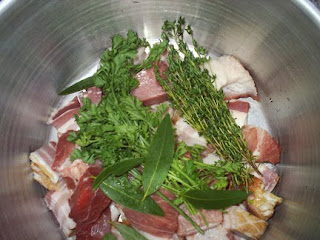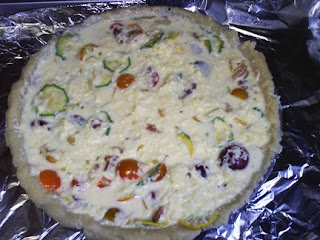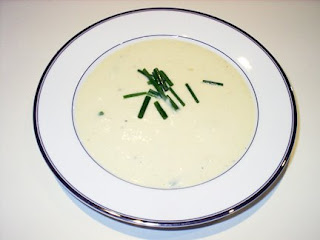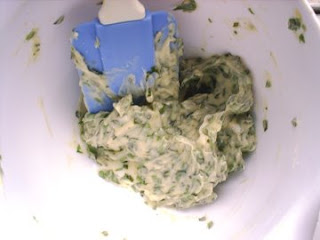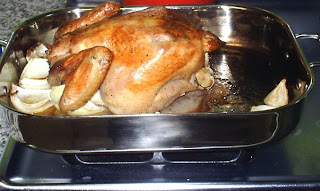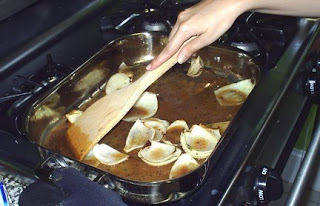Crème brûleé was the first really French dessert I ever ate while in Paris. I went as a treat for my 16th birthday (I know, super privileged, right? Not so much, actually went with my Dad who was there on business and decided it would be fun to take me and Grandma along... well we all had to share a tiny room and they snored, so I ended up sleeping in the bathtub every night. But Paris!) We had our first nice dinner at the restaurant atop the Musee d'Orsay, which was amazing. I had escargots for the first time at that meal, which I piggishly refused to share (more garlic butter for me). But when dessert time came, I had my first bite of vanilla-infused custard with crunchy sugar top, and it was love at first bite. It's still my favorite dessert, and I particularly love it infused with tea flavors, like earl grey, jasmine or matcha. But vanilla is still the best.
Mom also loves crème brûleé--it is her favorite dessert too--so I knew when I saw the recipe in the Les Halles Cookbook I'd have to make it for her. The opportunity arose this weekend when she decided to host family dinner when my sister came into town from Chicago. Well, sort of decided. The conversation went a bit like this.
Mom: "Sister M has asked for her favorite dinner tonight--Thanksgiving turkey and all the sides."
Me: "There is no way I am making a fucking turkey. But I'll make dessert."
Mom: "What's for dessert?"
Me: "Crème brûleé."
Mom: "Ooooh..."
Done and done. I had egg yolks to use up and a tube of vanilla beans, so I was ready to go. I hauled these, plus my ramekins out to the suburbs to cook dessert in mom's kitchen.
Tony's crème brûleé recipe is easily the richest I have ever made. Most call for a mix of cream and milk, with four to six egg yolks. Tony wants a full QUART of heavy cream and TEN egg yolks. It took all of my eggs plus all of mom's eggs to get the right amount.
First I halved the vanilla bean, and scraped the middles into the cream with a knife, putting the shell into the cream once it was scraped clean.

Add sugar, then put the pot onto the stove to boil.

Next, whisk the remaining sugar into the egg yolks. Once the cream boiled, Husband J helped to slowly pour splashes of cream into the yolks, while I whisked to make sure they didn't curdle. We poured the mixture into ramekins, which we put into pyrex dishes half-filled with water.

They went in the oven for 50 minutes, until the tops were set, but jiggled a little.

The custards cooled while we finished our turkey, stuffing, mashed potatoes, sweet potatoes, steamed vegetables and cranberry sauce. As the family relaxed on the deck, I dumped a tablespoon of granulated sugar (Tony calls for brown, but Mom's brown sugar was disgustingly rock-hard, so granulated it was) on top of the custards. They went under the broiler, set on high, until the sugar liquefied, caramelized and charred a little.

I served them still warm--we couldn't wait for dessert much longer. Everyone went crazy for these crème brûleés, though by the time we got through our dinners AND dessert, we were all feeling pretty gluttonous and nauseated. (The desserts were BIG, too.) Everyone scraped their bowls pretty clean, except mom who insisted on saving half of hers (and pouring everyone's scraps into her ramekin) for lunch tomorrow. For me, the vanilla bean really made the dish. I'd never actually made a dessert with a vanilla bean before, having previously only used vanilla extract. Even with the random Indonesian beans I found at Whole Foods (which were NOT cheap by any means), the vanilla flavor was super strong yet subtle and just plain delicious. I also liked using so much sugar on the tops, as they cracked like very proper crème brûleés in a satisfying way. I like crunching the top and mixing the bits into the cream so that I get sugar top in every bite. Delicious! Grandma even said I'd beat out the crème brûleés made by Cousin A, who is a pastry chef... though I'm pretty sure she was just being nice. All in all, a big dessert success.
Oh, additionally, we brought some of the rillettes over as an appetizer, and even picky Sister A ate and enjoyed the delicious porky goodness. We have one more big tupperware of pork to go. Takers???
Lessons learned: Vanilla bean is always best. With crème brûleé, the richer the better, but I kinda want to throw up now. I'm so going to gain 30 pounds while doing this project.
Next week: Soupe au Pistou




